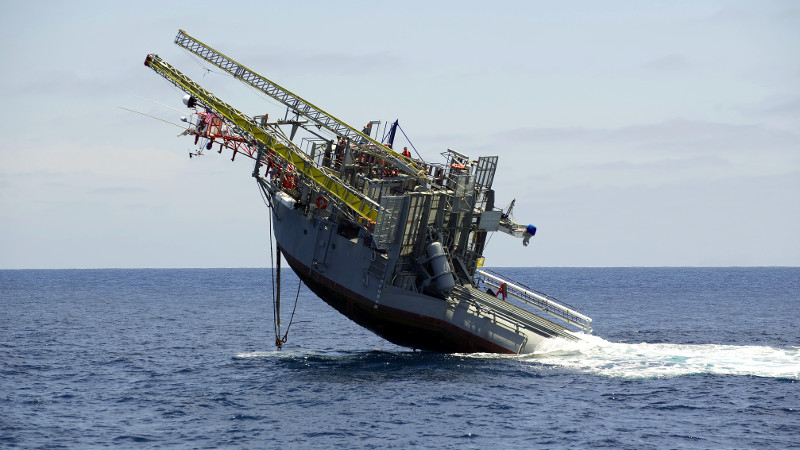It looks like a ship when it is in port or in transit, and when it use you’d think it’s about to sink. The RP FLIP (for “FLoating Instrument Platform) is an unpowered research buoy with a very special design designed to provide the most stable and vibration-free platform possible for scientists studying the properties of the sea.

Scientific research often places demanding requirements upon existing infrastructure, requiring its own large projects tailored to their individual task. From these unusual needs sometimes come the most curious buildings and machinery. RP FLIP is designed to provide the most stable and vibration-free platform possible for scientists studying the properties of the sea. By flooding tanks in its bow it transfers from horizontal and floating on the surface to vertical and half-submerged when it is deployed. With its stern protruding from the water and pointing skywards it has the appearance of a sinking ship. What’s really neat is that its interior is cleverly designed such that its crew can operate it in either horizontal or vertical positions.
The original impetus for FLIP’s building was the US Navy’s requirement to understand the properties of sound waves in the ocean with relation to their submarines and presumably also those of their Soviet adversaries. Research submarines of the 1950s were not stable enough for reliable measurements, and the FLIP, launched in 1962, was built to address this by providing a far more stable method of placing a hydrophone at depth. Since then it has participated in a significant number of other oceanographic studies as diverse as studying the propagation of waves across the Pacific, and the depth to which whales dive.
The videos below should give a good introduction to the craft. The first one is a glossy promotional video from its operator, the Scripps Institution Of Oceanography, on its 50th anniversary, while the lower of the two is a walkaround by a scientist stationed aboard. In this we see some of the features for operating in either orientation, such as a toilet facilities mounted at 90 degrees to each other.
It appears that FLIP is in good order and with continuing demand for its services that should see it still operating well into the future. Those of us who live near Atlantic waters may never see it in person but it remains one of the most unusual and technically intriguing vessels afloat.
FLIP is not the only 1960s oceanographic research buoy we’ve covered, should you have an interest in such things.
Header image: Office of Naval Research from Arlington, United States [CC BY 2.0]















I think you have “stern” and “bow” reversed in the article.
Yes stern and bow are reversed in the article where the part that is flooded is covered, flood the stern and the bow with the living and work area is up and out of the water.
FLIP was built in 1962
I remember back in grade school seeing a video about FLIP. It was so space age to us kids at the time. Glad to see it is still in operation.
Anyone else get motion sick watching the second video?
I stopped it about half way through, my forehead is beaded with sweat.
I took a dramamine before watching it. Still sick.
I used to see this boat/ship/buoy/contraption when it was docked in San Diego Bay (we lived in Point Loma).
Me too, but I think I saw it off of the end of Scripps Pier (we lived in Serra Mesa). I think you lived where the submarines pens are/were.
You may wash your hands at any time, but no showering or pooping when she is underway, only once vertical.
Sure about that? I was on this ship once. The cook system was on gimbals. I don’t see a reason that the head couldn’t have been similarly designed.
I think plumbing is a bit harder to put on a gimbal.
Seems that this would be a huge oversight on the designers’ part if this were true. Naval voyages can take days or even weeks, and you cannot expect a crew of 6 and up to 11 scientists to never need to shower or poop in that amount of time. Just doesn’t make sense to me.
The single head and shower are clearly visible in the footage of the two sinks.
FLIP is towed to the research site, so it doesn’t need to be crewed for the journey, aside for prepping to flip, which would not be a long period of time.
Who needs a toilet? You just take your sunday paper and and sit off the end of one of the boom platforms. Best pooping view anwywhere.
For a few years I’ve had the idea to build a canoe like this, where you can submerge the front and the back will stick out of the water, and you can sit on top and fish as it sticks out of the water.
I had a boat that could do that. And it did. Once.
(c:
Titanic?
Is it just me or does anyone else think that this would be a great way to launch a rocket from the ocean? Easy to put the rocket on the ship on it’s side, tow it out to sea, tip it up vertical and cold launch it from a tube and ignite.
Like…a submarine?
Well the FLIP is over 100m long, the largest SLBM is about 17m long, the Delta IV is around 70m long, so no, not like a submarine, cheaper and easier too.
Easy target for a terrorista. Doesn’t move very well. Subs on the other hand…priceless.
You know I’m not talking about an SLBM but a space launch vehicle, Elon Musk, not Uncle Sam.
It didn’t look like it could move on its own. In fact, there was a shot from a tug looking back at the FLIP.
The Nazis had just such a design. A long submarine launcher towed by a U-Boat. To fire it would be turned on end.
I was called Prüfstand XII if you want to google a bit.
I think it might be easier to just use a regular boat, and tip the rocket up when it’s time to launch. Even advanced stabilization for the launcher might be cheaper than having the whole ship be built to turn sideways
That is more or less what we did last summer, albeit a low tech version using a drainpipe and concrete weights =)
https://www.youtube.com/watch?v=VFJaG5YYffc
It’s not just you, other people have thought about it and came up with the Sea Dragon design. A super heavy “big dumb booster” that was only possible to launch at sea. The idea was that it would use conventional manufacturing techniques to reduce costs building it out of 8mm steel sheet in a shipyard. It’s one of the largest rockets ever proposed and would have had a payload of 550kg to LEO.
https://en.wikipedia.org/wiki/Sea_Dragon_(rocket)
I remember this from when it was first launched, an engineering marvel for sure, thanks for posting this and the videos, but OSHA must not know about this as I saw some glaring safety issues with the walkways,
#METOO!
Like how the mid boom has no safety cable at all? Or how none of them have rails on both sides? Or how people have to clamber over railings and equipment to get onto two of the booms? Just as bad was how does one reach the ladder down to the lowest deck? Looked like a person would need to be an acrobat to get to and from the ladder.
I can’t be the only person who kinda hates watching video of that thing. Stop! You’re gonna die!
No, you’re not going to die. There is enough safety stuff on that buoy to be safe if you are not an idiot and reasonably fit. I imagine that these criteria are selected for in the crew before the mission.
Just don’t ever let Joe Public on board. Joe Public needs safety levels orders of magnitude more comprehensive.
That “research in acoustics” …
Is that what makes whales go deaf @ 2000km distance?